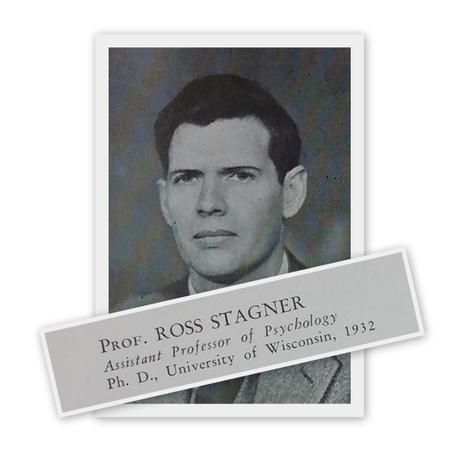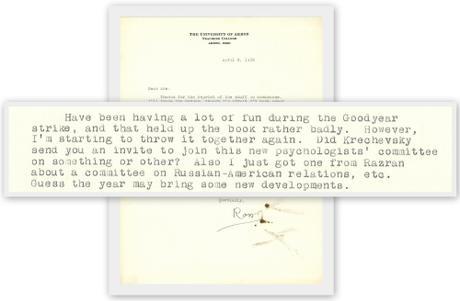Contributed by Lizette Royer Barton, Reference Archivist.
Ross Stagner is well known in the history of psychology for his work in Industrial/Organizational Psychology, the study of personality, and his involvement with the founding of the Society for the Psychological Study of Social Issues.
And it started here in Akron, Ohio!

Ross Stagner’s 1936 Tel-Buch faculty photograph
Photo credit: Archival Services, University Libraries, The University of Akron
Ross Stagner accepted his first regular faculty position at The University of Akron in 1935 and the United Rubber Workers organized that very same year. According to Stagner’s SIOP autobiography, “My enthusiasm soared when, on my first day in that city, I saw a huge banner welcoming the “Rubber Workers Organizing Committee….”[and] before long I had gotten involved in educational and organizational efforts of this group.”
At one point Akron was the Rubber Capital of the World as companies like Goodyear, Goodrich, Firestone, and roughly twenty other lesser known rubber factories called Akron home. The rubber industry employed 40,000 Akronites at its peak but according to Brecher (1972) by 1933 nearly half of Akron’s rubber workers were unemployed. Firestone and several other factories had closed and Goodyear was operating on a two-day work week.
The early 1930s were an interesting time in the history of industry and a critical time in Akron industry. Among other things, Congress passed the National Industrial Recovery Act in 1933 and section 7A included a provision that allowed employees the right to organize and bargain collectively without interference or coercion from employers. This opened the gates for thousands of Akron rubber workers to join local trade unions and the United Rubber Workers Union (URW) was established in 1935.
Stagner’s arrival in Akron coincided with the height of trouble in the Akron rubber industry. In response to increased production demands and decreased wages, workers organized numerous strikes at several different companies in the early 1930s. Then, on February 14, 1936 tirebuilders in Goodyear’s Plant No. 2 shut off their machines and sat down signaling the start of a giant “sit-down” strike. In addition to the sit-downs, workers also organized long picket lines and production at Goodyear Tire and Rubber came to a halt.
A settlement was reached on March 22, 1936 with the management at Goodyear accepting the majority of the workers’ demands.
Industrial/Organization Psychology wasn’t Ross Stagner’s focus in graduate school and in fact he’d never even had a single course on the topic. However, he admitted to learning a great deal about industrial working conditions from the rubber workers and according to Zickar (2004) he went on to be one of only a handful of early researchers in the field to take a pro-union stance. He conducted numerous research studies throughout his career that focused on union commitment, collective bargaining, and union socialization. And aside from his pro-union work in Industrial/Organizational Psychology he was also a pivotal, founding member of the Society for the Psychological Study of Social Issues in 1936 – a group dedicated to using psychology to make social change.

Ross Stagner to Abraham Maslow, April 1936
Abraham Maslow papers, box M4495, folder 3
Cummings Center for the History of Psychology, The University of Akron
References:
Brecher, J (1973). Strike!. Straight Arrow Books, San Francisco, CA.
Goodyear Tire and Rubber Company Records, 1898-1993. Archival Services, University Libraries, The University of Akron.
Lachman, S. J. (1998). Ross Stagner (1909-1997). American Psychologist, 53(4), 482-483.
Abraham Maslow papers. The Cummings Center for the History of Psychology, The University of Akron.
Ross Stagner papers. The Cummings Center for the History of Psychology, The University of Akron.
Zickar, M. J. (2004). An analysis of industrial-organizational psychology’s indifference to labor unions in the United States. Human Relations, 57(2), 145-167.
